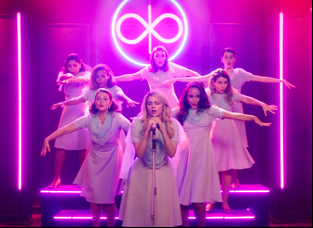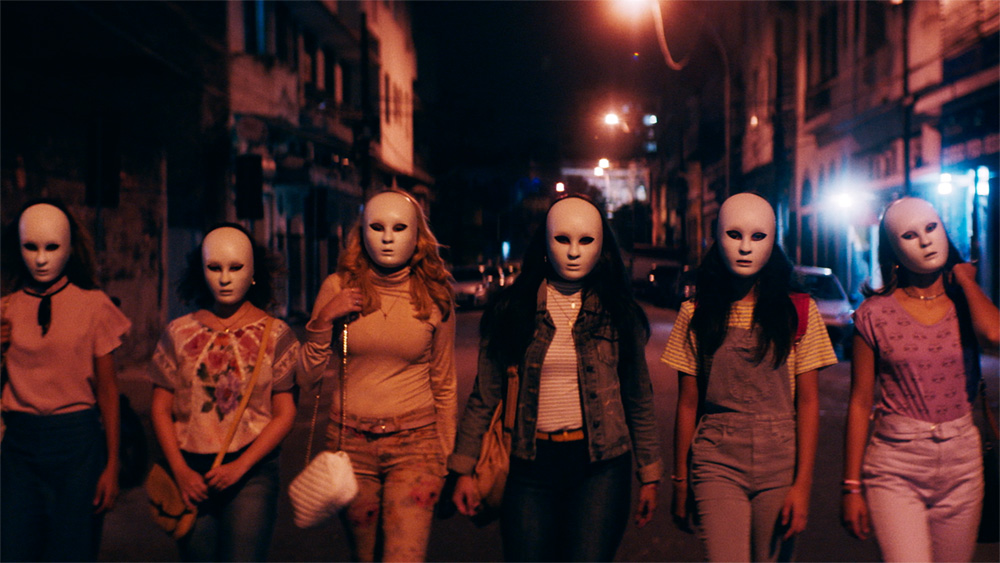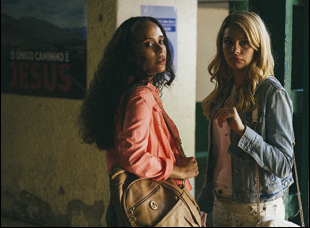“Knowing how to show yourself is vital for the modern Christian woman,” Michele (Lara Tremouroux) says in “Medusa,” applying concealer to Mariana (Mari Oliveira), a member of her flock, for an Instagram post. You can’t be sure if it would be more gratifying for her to gain more followers for herself or for the Good Lord, but like many things in Anita Rocha da Silveira’s scorching satire of present-day Brazil, the selfish is often made to look selfless these days when makeup tips are really just a savvy way of putting a good face on the ugliness of the right-wing movement in the country, which has made no secret of plans to purge society of the gay and lesbian community and deprive women of agency under the guise of Christianity.
Although Michele is more than happy to put her face out in public as a social media influencer, she keeps it under a mask at night for other kinds of viral videos, rounding up her gang of girls to beat up other young women she finds impure and “Medusa” tracks Mariana as she starts to question what they’re doing as the videos rack up thousands of likes, but their activities are clearly unholy. After previously teaming with Oliveira to explore how living in an area plagued by murders could shape the perspective of a 15-year-old in her debut “Kill Me Please,” Rocha da Silveira shows a war being waged in both the virtual and physical realms as Mariana becomes disillusioned with the world around her, coming into contact with those she’s helped disfigure in volunteering for a local clinic while seeing how savvy Michele is at recruiting more to her cause online.
It is only natural that Rocha da Silveira was drawn towards the style of ‘70s giallo films to convey such horrors, taking the bright lights of Rio de Janeiro and turning them into a phantasmagoria for Mariana to work her way through as she moves between the artificiality of the environments that have been created for Michele’s perfectly tailored social media posts and the rainforests she must walk through to get to the clinic where she can feel the ground beneath her feet. Both formally and substantively audacious, “Medusa” is punctuated by a rebel yell that hasn’t stopped echoing around the world since its debut at Cannes last year, finally reaching America this week and the filmmaker spoke about how even she was surprised by how loud her cast was willing to get, delving into Greek mythology for inspiration and putting together the film’s sensational soundtrack.
The film was inspired by news articles about a group of three [to] five girls getting together to get a girl that they consider promiscuous, and when I read this article, it symbolizes a lot of the conservative rise that we could feel in Brazil since 2013 and reminded me of the Medusa myth because in the myth, Medusa was very pretty and she was punished by Athena, a virgin goddess. In one version of the myth, she was raped. In others, she fell into temptation. But since she was no longer a virgin, she was transformed into this horrible creature that we all have heard about, so that was the starting point.
At a certain point, Mariana gets a scar, which I understand came from mythology too. How did that make it in?
There’s a myth that I really like — that Chiron was a demigod and was hurt by an arrow with some special poison and he had this this wound in his leg that couldn’t be healed because of the poison in the arrow. This mark was something that made Chiron start to get in touch with his [feminine] side because he had this wound, that couldn’t cure. He was living as a god, and this mark was something that reminded me about being a woman and of what happens with Mariana because she’s basically a robot in the beginning of the film — she’s following others, she’s following the church says is what’s right and wrong. And the cut in the face wakes this another side of her, something that forces her to change and to put herself in different situations, so somehow a mark puts her in touch with a more [feminine] side of her.
Was it difficult to figure out what kind of masks you wanted?
No, not so much. It was important for there to be white masks because of the way the girls see themselves as angels, even though they’re not, but then we didn’t have the budget to do [form-fitting] masks, so it was basically seeing what was available in the markets. We found this mask that really fit all the actors. And the film has other masks — there’s all the animals masks, Medusa’s mask, and it’s a film for masks at the end of the day, some inspired by some Greek myths, and [there are] different meanings for the mask.

I’ve known Mari since she was 15 and I had her in mind when I was writing and one of the reasons that she’s a very good actress and someone that’s very, very nice to work with, so was when I was writing, I thought about Mari because I knew that should be perfect for the role and someone that would to bring things that were interesting to the character. And in my process, I start to rehearse some months before shooting and I like to work all the dialogue with the actors before [locking it down with] them. Two weeks before the shooting is when I close the scripts, but during the rehearsal process, I like to see what sounds comfortable for everyone to say because sometimes some things in my mind, they sound really great, but in practice when I start to rehearse, not so much.
And it was important to go to the set with things more secure because we didn’t have time to improvise or for things to go wrong. “Medusa” always shot in 28 days, so everybody had to be prepared and in the process of rehearsing the girls and for them to bond, we started with some choir practice. [Carol Romano], who plays Vivian, had some experience with choir, so she took the lead on rehearsal with the girls and creating the vocals and it was a very nice way for them to bond and to get in the same place.

It was, and for this film, we were struggling with very low budget and [“House of the Rising Sun”] is a public domain song, so that was one of the main reasons why I chose this and it was also important to be something that people would recall that being some sense of familiarity. But also this is a song that I really like, and it was fun to transform the song into something more right wing for the film.
This music that’s sung in the film came in a very early stage, and then I wrote different versions for different music to see what was approved, what was not, what was in the budget and which composers would authorize the versions of their songs. During the editing, I experiment with different songs a lot, and Bernardo [Uzeda, my composer] worked more in the on the climax songs, that for me were very clear since the beginning — the tone was inspired by Goblin, by Tangerine Dream, by [John] Carpenter and something that I didn’t have to worry much about because we have the, we have the same reference.

No, I don’t think changed the tone, but on my first feature, it was also the first feature of my [cinematographer], so we were much more afraid and it was very important to commit to the colors from the beginning as a statement and a more old look because now it’s much more common for people to add color in the color grading, and I see a lot of people afraid of using colors on set. For us, it was important to choose the colors — green was the main color, very much about the nature, and the snake as the Medusa element, and red [could reflect] the opposition — the color of blood, of life — so I started from the green and reds, and we used a lot of blue and purple and pink in the middle, so it’s a very colorful film and that was important for our process and to have fun with that.
Was there a particularly crazy day of shooting?
The scene of the girls screaming in the street was very fun and very cathartic for everyone. I was not expecting it, since at the beginning I said to the actresses to not scream because I was afraid they would hurt their voices and had to shoot shoot more scenes in the days [ahead] and I thought that I was going to do the ADR for the scene, but was not the case. They decided to scream for real and I couldn’t stop them. They start to scream, scream, and scream, so the sound of the film is the sound from the set and it was a very fun day of shooting.
“Medusa” opens on July 29th in New York at the Angelika Film Center in Los Angeles at the Laemmle NoHo and the Drafthouse DTLA before expanding on August 5th. A full list of theaters and dates is here.





